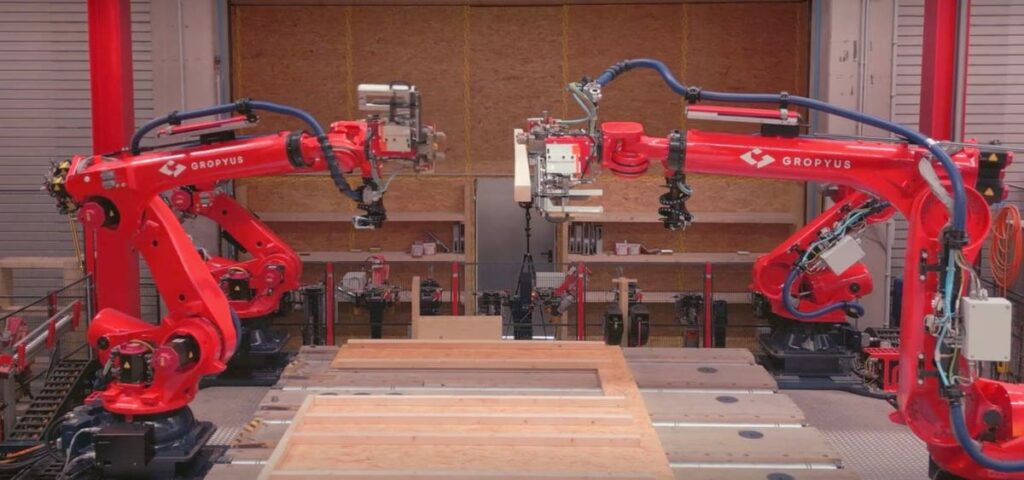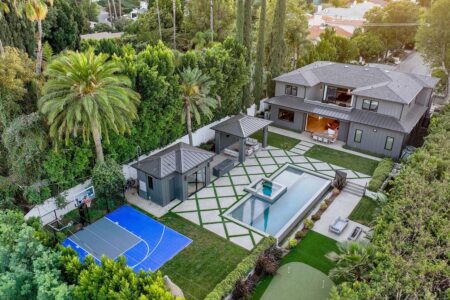Our phones, computers, watches and other devices prompt us to download updates to the operating system as often as there is a bug to fix or a new feature to roll out.
Bernd Oswald, co-founder and head of business development at the German-Austrian proptech company Gropyus, is on a mission to update housing’s operating system, from pre-design to continued management and experience, and is changing the way we think about housing as a product.
Gropyus’s founders are serial entrepreneurs who had not been involved in the housing industry, but were looking for the next industry to tackle, and construction stood out like a golden egg.
“The industry itself was broken, productivity was low,” Oswald said. “We wanted to find out how we could get the principles of technology and industrialization to both help mitigate the environmental and societal issue of affordable housing and attack the two things at once.”
To do that, the company looked at creating a housing product end to end.
“In construction, we don’t understand the broader impacts and systems thinking and only look at the tiny slice of value chain without looking at the global optimal,” he said. “The only way to approach it is to look at the process end to end—it’s planning, manufacturing, assembly, software, user experience, facility management.”
With about 400 employees at Gropyus, about one-third are software engineers working on parametric design to replace the traditional role of the architect. Those precise designs inform the building system and the manufacturing line and the billing system, building the entire value chain into a turnkey solution for affordable housing.
“We still believe in machine-to-people interfaces, and we should think about machine-to-machine interfaces,” he said. “Machine-to-human interface might be what we need in our mind to believe and trust in a process, but it doesn’t add any value. We still have people reviewing drawings, but a machine could do that at equal quality and faster.”
While most of the industry sees building information models, or BIM, as a high-tech end goal, Oswald dismisses it as a useless invention. He’s sprinting toward a milestone to help the industry realize that a machine can be trusted more than a person, which he predicts will happen soon.
Through this process, Gropyus delivers panelized, flat packed, timber framed housing with incredibly tight tolerances in its own manufacturing cells that have the capacity to produce 3,500 units per year. More than a year ago, Gropyus was able to complete a 9-story building with 54 units with volumetric module bathrooms in 11 weeks from foundation to finished building.
Net-net, a Gropyus home costs less than a conventionally built home. Oswald says that while the construction costs are equal to conventional construction, Gropyus’s end product is an energy-positive, carbon-neutral building that operates at a lower cost.
The company carefully selects every material to meet certain criteria, including being able to be lifted by a crane. This doesn’t come to the company in a vacuum—it collaborates with suppliers.
“There is a natural reduction of suppliers who will collaborate, but like car manufacturers, we look at performance levels, delivery aspects, quality, and volume,” Oswald said. “We won’t always align with the cheapest suppliers. We can always find a cheaper solution, but that doesn’t benefit anyone.”
Creating the right, most affordable solution comes down to a joint product development process with supply chain partners that can deliver to a design, be as automated as possible, and at the lowest cost.
For example, through group think, the company and its suppliers will decide that a manual task such as screwing a metal plate on to a sink might be best suited for the manufacturer.
“We examine who has the best precision on what needs to be done,” he said. “Sometimes you might find out that the manufacturer has a better perspective on how to approach a solution than we do. We have learned that we shouldn’t specify without involving our suppliers because we don’t know what their cost structures are.”
Living as a Service
“We don’t build houses, we create an environment for learning – it’s ‘living as a service,’” Oswald said. “It’s more than just shelter. It’s the whole interaction that they have with where they live.”
Gropyus takes a strategic approach to the consumer experience, doing field research to understand customers’ needs and if the product fits the market. The company recently completed 1,500 focus group interviews to find out how customers perceive the purpose of their living spaces.
From the research, Gropyus produced four customer “mindsets” that it uses to deliver a product to fit anyone. Each mindset defines how they see the world. For instance, there is a “safe place” mindset, who is someone with less interest in engaging with neighbors, they like very bright hallways, it’s important to them where and how to park the car and if their balcony is visible to other places.
Another mindset is someone who just goes home to sleep. That person is very social, so they enjoy engaging with neighbors, and they just want the smallest space necessary to live and sleep. They are also mindful of how resources of the planet are spent.
“For us, it is important that each persona is considered in the way we offer the product,” Oswald said. “It helped us develop different unit sizes. We offer more than everyone needs, but they can opt out. The building has features that we believe to be important, but it is what the residents tell us since they are the end users.”
With its entire experience and product offering, Gropyus can create environments that are more than just a house or four walls, but that offer the opportunity for people to interact, and even open the door to developing more sustainable behaviors.
“Creating e-bike stations will change the behavior of how residents commute,” he said. “If you have shared facilities – like indoor farming, children’s playgrounds – really for the interaction of people, which could be physical or digital spaces, it impacts how they continue to operate and to live.”
Leveraging the technology for better ongoing performance, Gropyus has a digital twin of the property that tracks operations. Residents can collect data on performance, determine where and how they can save, and enjoy the benefit of learning how they can have a positive impact on the carbon footprint. Being able to see the data helps incentivize people to live a more sustainable life.
For instance, when a resident sees a weekly energy bill come in above normal, they can track energy consumption, and adjust their behavior because they have access to the data to make informed decisions.
The OS Marketplace
The challenge with the in-home user experience that Gropyus and other developers are creating has been the fragmented market—there isn’t a unified interface or business model.
Elizabeth Parks, president and chief marketing officer at market research firm Parks Associates, says that consumers expect Uber-like experiences where technology is built in the experience and works.
“Younger generations in a college environment are the most high tech,” she said. “They need internet to do schoolwork, so student housing has good connectivity with safety features built in. Then, when students leave and look to rent an apartment or build a house, they expect technology to be built in.”
Right now, Parks Associates research shows that 50% of apartment residents have WiFi issues, and there are more demands than ever for better connectivity, from streaming and gaming to working from home. Big investments are being made in in-unit automation and convenience, door locks and access control, maintenance solutions, cameras and security solutions, smart parking spaces, energy management analytics and control.
More developers are thinking about the building as an asset that has future service revenue with bulk services such as broadband. There are a few large players in a race to control the entire ecosystem for a more seamless user experience.
For instance, Amazon just revealed the Amazon Hub, a platform to control all of its products, like Amazon Prime video services, Ring, Blink cameras, speakers, and the company has plans to offer broadband service through satellite. When everything is launched, a homeowner could have an all Amazon home making the technology giant the closest to being able to provide such a solution.
She also pointed out that legacy security company ADT is diversifying to go beyond security and become a home service provider with expansive relationships extending to Google and State Farm Insurance. Other strong players able to offer more of a whole home experience include Samsung and SmartThings, and there are emerging players like Roku, which is a streaming entertainment platform, and is now introducing professional monitored security services that integrates with the TV, the largest screen in the home.
Slow Change
The automation of the construction and user experience process may seem like a quantum leap for some legacy industry players.
Agustin Rayon, the president and CEO at California-based Plant Prefab, joined the company recently to open a new facility designed purposefully to produce both panels and modules under one roof.
“It’s a lot more difficult for a builder to get fully modulized and can be an issue with adoption,” he said. “With stick building and framing as most of construction, those who want to do the transition find it easier to have a stepping stone.”
Rayon says the company’s strategy was clear – there was no other factory doing both panels and modules, but both have advantages.
“Modules are good, but expensive to ship, so you have to compromise,” he said. “Using panels means you don’t have to compromise your program, but you have more site work to do that would be done with the modules.”
Plant Prefab used this logic to offer both, which also means that a builder’s plans don’t have to be forced into a system. Since the factory has the flexibility, it can take on projects that are ready for site construction without having to change the plans.
In a recent shift, Plant Prefab is going from selling direct to consumers to offering this phased-in process to developers and builders to deliver much needed affordability with a foundation in sustainable construction. Its fully automated process also is able to offer a sophisticated level of reporting to clients on how much material is going into the walls.
Investing In The Future
Gropyus is looking for developers in the U.S. to start new manufacturing facilities using its intellectual property of the robots, processes, and software. Oswald calculates that a manufacturing plant that could do 3,500 units would cost between $50 and $75 million.
It would be a safe bet for investors focused on ESG in construction. Gropyus has done an embodied and a 50-year operational carbon calculation and lifecycle assessment using a large share of recycled materials and even considering the disassembly process showing that its product is energy-positive and carbon-neutral.
With sustainability metrics and otherwise, the future is all about the infusion of technology everywhere, enabling a host of new services and creating a massive marketplace. Parks calculates that U.S. annual spending across home phone, internet, mobile, security, and video services is $340 billion.
“It could be Amazon delivering groceries to your refrigerator, it could be people letting themselves into your apartment,” Parks said regarding this big opportunity. “Broadband will be the fuel for the revenue on the other side because of the service driven market we are in. That’s why all the big players want to own the whole thing – it is all the information that they can collect about you and then use it for product development and promotion strategies.”
The tradeoffs are inherent. Residents can have an affordable, sustainable, healthy living experience for unlimited insight into all of their daily activity.
Read the full article here













